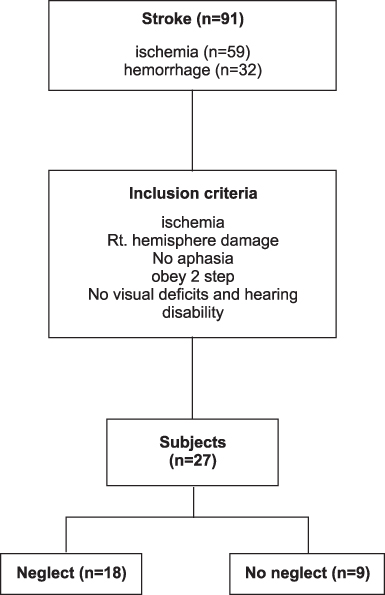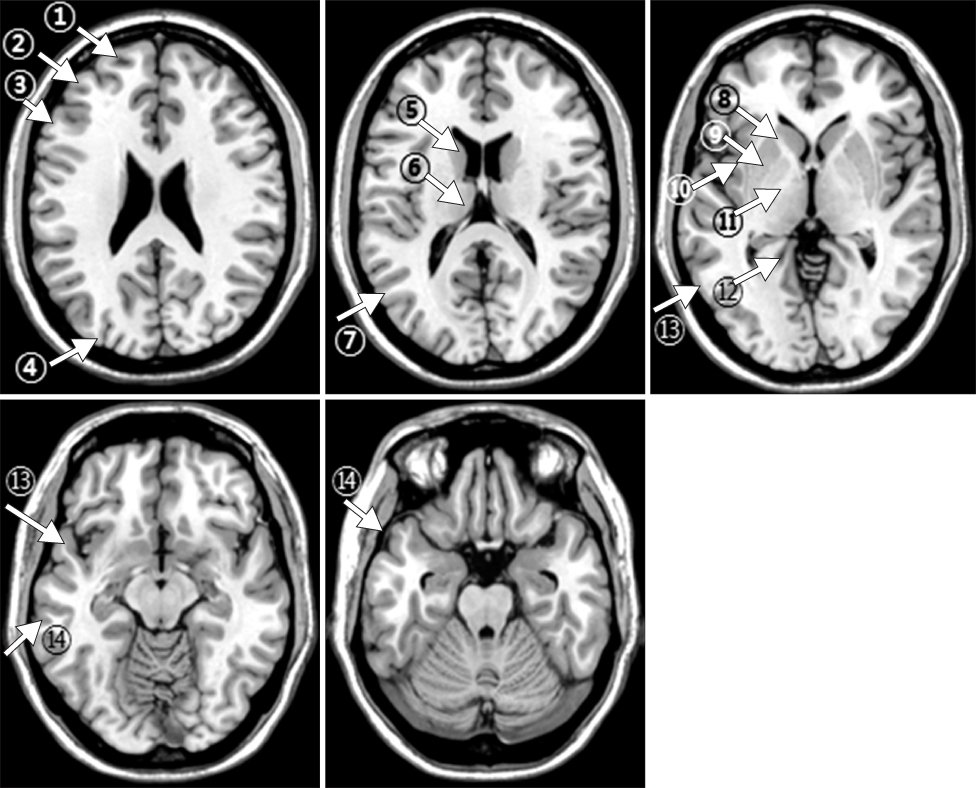Brain Neurorehabil.
2016 Mar;9(1):37-47. 10.12786/bn.2016.9.1.37.
Relationship between Comorbid Cognitive Impairment and Functional Outcomes in Stroke Patients with Spatial Neglect
- Affiliations
-
- 1Department of Rehabilitation Medicine, Konkuk University Medical Center, Korea. leej@kuh.ac.kr
- 2Department of Rehabilitation Medicine, Konkuk University School of Medicine, Korea.
- KMID: 2161460
- DOI: http://doi.org/10.12786/bn.2016.9.1.37
Abstract
OBJECTIVE
The aim of this study was to investigate relationships between cognitive impairment and functional outcomes in stroke patients with spatial neglect. METHOD: Twenty seven right hemisphere ischemic stroke patients who admitted to an inpatient rehabilitation unit were included. Patients were divided into two group based on KF-NAP scores: Neglect group (n=18) and non-neglect group (n=9). Neglect group (n=18) were subdivided into two groups by discharge FIM scores as poor outcome group (n=8, <70) and good outcome group (n=10, ≥70). Cognitive function assessments including attention (Attention & Calculation, Digit span test-Forward), memory (Digit span test-Backward, SVLT-Immediate recalls/Delayed recalls) and visual perception (LOTCA-Visual perception/Visuomotor organization), and stroke severity assessment including NIHSS, FMA, K-MMSE, and FIM were performed. Cognitive impairments and functional outcomes were compared between two groups.
RESULTS
There were significant differences in NIHSS, FMA (affected U/E, affected L/E), discharge FIM, FIM gain and LOTCA-visuomotor organization between Neglect group and non- neglect group (p<0.05). Among the patients with spatial neglect, there were significant differences in KF-NAP, K-MMSE and assessment scores of memory and visual perception between poor outcome group and good outcome group. Attention, memory and visual perception were significantly correlated with KF-NAP scores (p<0.05).
CONCLUSION
Stroke patients with spatial neglect showed more severe impairment in cognitive, motor and general functional status, which resulted in delayed functional recovery. Spatial neglect patients with combined memory and visual perception impairment may show poor functional outcome.
Keyword
Figure
Cited by 1 articles
-
Relationship Between Line Bisection Test Time and Hemispatial Neglect Prognosis in Patients With Stroke: A Prospective Pilot Study
Shinyoung Kwon, Wookyung Park, MinYoung Kim, Jong Moon Kim
Ann Rehabil Med. 2020;44(4):292-300. doi: 10.5535/arm.19112.
Reference
-
1. Bowen A, Lincoln N. Cognitive rehabilitation for spatial neglect following stroke. Cochrane Lib. 2007; 2:1–52.
Article2. Urbanski MA, De Schotten MT, Rodrigo S, Oppenheim C, Touzé E, Méder JF, Bartolomeo PA. DTI-MR tractography of white matter damage in stroke patients with neglect. Exp Brain Res. 2011; 208(4):491–505.
Article3. Paolucci S, Antonucci G, Grasso MG, Pizzamiglio L. The role of unilateral spatial neglect in rehabilitation of right brain–damaged ischemic stroke patients: a matched comparison. Arch Phys Med Rehabil. 2001; 82:743–749.
Article4. Halligan PW, Fink GR, Marshall JC, Vallar G. Spatial cognition: evidence from visual neglect. Trends Cognit Sci. 2003; 7:125–133.
Article5. Vallar G. Extrapersonal visual unilateral spatial neglect and its neuroanatomy. Neuroimage. 2001; 14:S52–S58.
Article6. Mesulam MM. Spatial attention and neglect: parietal, frontal andcingulate contributions to the mental representation and attentional targeting of salient extrapersonal events. Phil Trans R Soc Lond B. 1999; 354:1325–1346.
Article7. Chen P, Chen CC, Hreha K, Goedert KM, Barrett AM. Kessler Foundation Neglect Assessment Process Uniquely Measures Spatial Neglect During Activities of Daily Living. Arch Phys Med Rehabil. 2015; 96(5):869–876.
Article8. Yoo EY, Jung MY, Park SY, Choi EH. Current trends of Occupational Therapy Assessment Tool by Korean Occupational Therapist. J Korean Soc Occup Ther. 2006; 14(3):27–37.9. Plummer P, Morris ME, Dunai J. Assessment of unilateral neglect. Phys Ther. 2003; 83:732–740.
Article10. Chen P, Hreha K, Pitteri M. Kessler Foundation Neglect Assessment Process: KF-NAP 2014 manual. West Orange: Kessler Foundation;2014.11. Gillen R, Tennen H, McKee T. Unilateral spatial neglect: relation to rehabilitation outcomes in patients with right hemisphere stroke. Arch Phys Med Rehabil. 2005; 86:763–767.
Article12. Pedersen PM, Jorgensen HS, Nakayama H, Raaschou HO, Olsen TS. Hemineglect in acute stroke—incidence and prognostic implications. The Copenhagen Stroke Study. Am J Phys Med Rehabil. 1997; 76:122–122.13. Verdon V, Schwartz S, Lovblad KO, et al. Neuroanatomy of hemispatial neglect and its functional components: a study using voxel-based lesion-symptom mapping. Brain. 2010; 133(Pt 3):880–894.
Article14. Husain M, Rorden C. Non-spatially lateralized mechanisms in hemispatial neglect. Nat Rev Neurosci. 2003; 4:26–36.
Article15. Chen P, Hreha K. Kessler Foundation Neglect Assessment Process: KF-NAP 2015 manual. West Orange: Kessler Foundation;2015.16. Wojciulik E, Husain M, Clarke K, Driver J. Spatial working memory deficit in unilateral neglect. Neuropsychologia. 2001; 39(4):390–396.
Article17. Gainotti G, Tiacci C. The relationships between disorders of visual perception and unilateral spatial neglect. Neuropsychologia. 1971; 9(4):451–158.
Article18. Kang Y, Na DL. Seoul Neuropsychological Screening Battery (SNSB). 1st ed. Incheon: Human Brain Research & Consulting Co;2003.19. Katherine Salter BA, Mark Hartley BA, Norine Foley B. Impact of early vs delayed admission to rehabilitation on functional outcomes in persons with stroke. J Rehabil Med. 2006; 38:113–117.
Article20. Katz N, Itzkovich M, Averbuch S, Elazar B. Loewenstein Occupational Therapy Cognitive Assessment (LOTCA) battery for brain-injured patients: Reliability and validity. Am J Occup Ther. 1989; 43:184–192.
Article21. Azouvi P, Olivier S, de Montety G, Samuel C, Louis-Dreyfus A, Tesio L. Behavioral Assessment of unilateral neglect: Study of the psychometric properties of the Catherine Bergego Scale. Arch Phys Med Rehabil. 2003; 84(1):51–57.
Article22. Chen P, Hreha K, Fortis P, Goedert KM, Barrett AM. Functional assessment of spatial neglect: A review of the Catherine Bergego Scale and an introduction of the Kessler Foundation Neglect Assessment Process. Top Stroke Rehabil. 2012; 19:423–435.
Article23. Ling FM. Stroke Rehabilitation: Predicting Inpatient Length of Stay and Discharge Placement. Hong Kong J Occup Ther. 2004; 14(1):3–11.
Article24. Moeller T, Rief E. Pocket atlas of sectional anatomy [vol 1 head and neck]. New York: thieme;2007.25. Karnath HO, Berger MF, Küker W, Rorden C. The anatomy of spatial neglect based on voxelwise statistical analysis: a study of 140 patients. Cerebral Cortex. 2004; 14(10):1164–1172.
Article26. Karnath HO, Rennig J, Johannsen L, Rorden C. The anatomy underlying acute versus chronic spatial neglect: a longitudinal study. Brain. 2011; 134:903–912.
Article27. Karnath HO, Himmelbach M, Rorden C. The subcortical anatomy of human spatial neglect: putamen, caudate nucleus and pulvinar. Brain. 2002; 125(2):350–360.
Article28. Karnath HO, Rorden C, Ticini LF. Damage to white matter fiber tracts in acute spatial neglect. Cerebral Cortex. 2009; 19(10):2331–2337.
Article29. Wade D, Skilbeck C, David R, Langton-Hewer R. Stroke: a critical approach to diagnosis, treatment and management. London: Chapman and Hall;1985.30. Driver J, Mattingley JB. Parietal neglect and visual awareness. Nat Neurosci. 1998; 1:17–12.
Article31. Jehkonen M, Ahonen JP, Dastidar P, et al. Visual neglect as a predictor of functional outcome one year after stroke. Acta Neurol Scand. 2000; 101:195–201.
Article32. Denes G, Semenza C, Stoppa E, Lis A. Unilateral spatial neglect and recovery from hemiplegia. Brain. 1982; 105(3):543–552.
Article33. Brain Mort DJ, Malhotra P, Mannan SK, et al. The anatomy of visual neglect. Brain. 2003; 126(Pt 9):1986–1997.
Article34. Paolucci S, Antonucci G, Grasso MG, Pizzamiglio L. The role of unilateral spatial neglect in rehabilitation of right brain–damaged ischemic stroke patients: a matched comparison. Arch Phys Med Rehabil. 2001; 82(6):743–749.
Article35. Corbetta M, Kincade MJ, Lewis C, et al. Neural basis and recovery of spatial attention deficits in spatial neglect. Nat Neurosci. 2005; 8:1603–1610.
Article36. Robertson IH, Mattingley JB, Rorden C, Driver J. Phasic alerting of neglect patients overcomes their spatial deficit in visual awareness. Nature. 1998; 395(6698):169–172.
Article37. Stone SP, et al. Unilateral neglect: a common but heterogeneous syndrome. Neurology. 1998; 50:1902–1905.
Article38. Baddeley AD, Hitch GJ. Working memory. In : Bower GA, editor. Recent advances in learning and motivation, Vol. 8. New York: Academic Press;1974. p. 47–90.39. Katz N, Hartman-Maeir A, Ring H, Soroker N. Relationships of cognitive performance and daily function of clients following right hemisphere stroke: predictive and ecological validity of the LOTCA battery. Occup Participation Healt. 2000; 20(1):3–17.
Article40. LaBar KS, Gitelman DR, Parrish TB, Mesulam MM. Neuroanatomic overlap of working memory and spatial attention networks: a functional MRI comparison within subjects. Neuroimage. 1999; 10(6):695–704.
Article41. Hampshire A, Chamberlain SR, Monti MM, Duncan J, Owen AM. The role of the right inferior frontal gyrus: inhibition and attentional control. Neuroimage. 2010; 50(3):1313–1319.
Article42. Aron AR, Robbins TW, Poldrack RA. Inhibition and the right inferior frontal cortex. Trends Cogn Sci. 2004; 8:170–177.
Article43. Clower DM, West RA, Lynch JC, Strick PL. The inferior parietal lobule is the target of output from the superior colliculus, hippocampus, and cerebellum. J Neurosci. 2001; 21(16):6283–6291.
Article44. Corbetta M, Shulman GL. Spatial neglect and attention networks. Annu Rev Neurosci. 2011; 34:569–599.
Article
- Full Text Links
- Actions
-
Cited
- CITED
-
- Close
- Share
- Similar articles
-
- Effect of Computer-based Cognitive Rehabilitation on Unilateral Spatial Neglect in Stroke Patients
- Subtypes of Spatial Neglect and Assessment
- Brief Cognitive and Visuospatial Assessment for Patient with Stroke and Correlation of Cognitive Function and Functional Outcome
- Language-specific Dysgraphia in Korean Patients with Right Brain Stroke: Influence of Unilateral Spatial Neglect
- Neuroanatomy of Unilateral Neglect Syndrome



